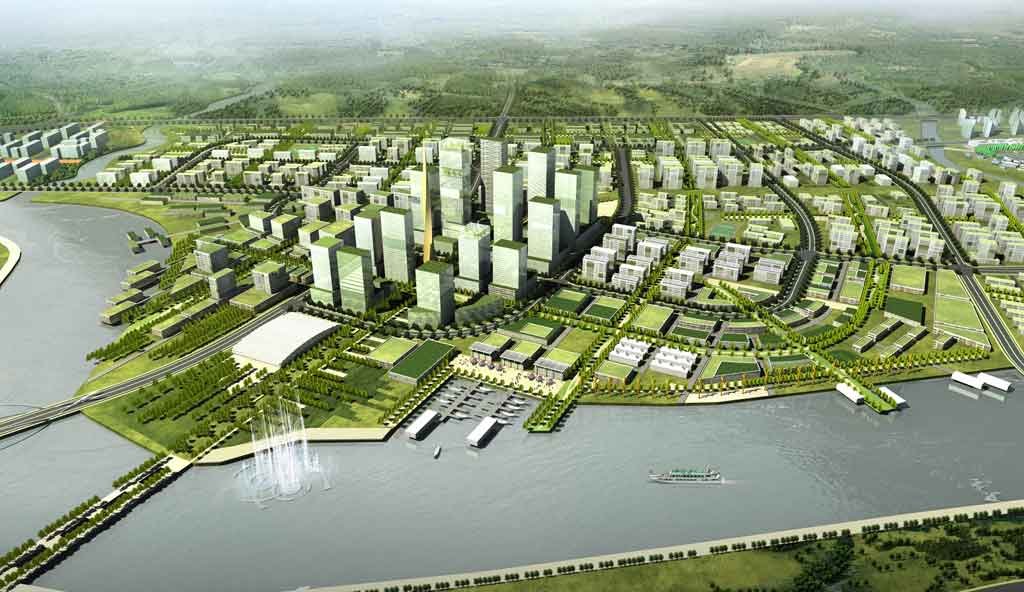
Like every year, people around the world are celebrating Earth Day on April 22 to remind each other of our beautiful planet and to motivate environmental conservation efforts.
As the world’s urban population continues growing and the effects of climate change become more life-threatening, it’s important and urgent for countries to build their cities more sustainable.
On the occasion of Earth Day 2014, let’s have “A Glimpse of the GEF’s Sustainable City Projects” around the world through the below article that Xiaomei Tan, the GEF’s climate change specialist, wrote for “The Greenline” April issue.

Eco-city overview. Photo © KepCorp.com
“Investing in sustainable cities reduces carbon dioxide emissions and generates added benefits of improving local environment. The Global Environment Facility (GEF) started investing in sustainable cities projects in 1999, when it simultaneously allocated $25 million to improve energy efficiency of Beijing’s district heating and $12 million to support hydrogen fuel cell buses in Sao Paulo. Built on the experiences from these two projects, the GEF urban portfolio today represents one of the largest sustainable cities programs in the world: this includes 63 projects in over 110 cities across 50 countries, with $412.2 million committed and an additional $6.53 billion leveraged in cofinancing from the private sector and elsewhere.
The GEF urban interventions prioritize projects with significant climate change mitigation potential. This priority is reflected in three categories of projects:
- Innovative urban technology solutions such as the development of hydrogen fuel cell buses, new building technologies, and smart traffic systems.
- Low-carbon transport systems such as transport planning, traffic demand management, public transport infrastructures and fleet improvement.
- Comprehensive urban strategies such as urban-scale building energy efficiency and renewable energy, municipal solid waste and sewage management, urban biodiversity and land use regulations.
These projects are executed in both newly-built urban areas and existing urban environment. Recognizing the importance of retrofitting existing urban environment to make it low-carbon and smart, the GEF in 2010 supported a comprehensive green energy scheme in one of the densest urban spaces in the world: Changning District, Shanghai. This comprehensive green energy scheme has several key components:
- Piloting a new near-zero-emissions building;
- On-site distributed generation from renewable energy and natural gas;
- Retrofitting HVAC (heating, ventilation, and air condition) systems in commercial and public buildings;
- Redesigning local public transport systems to connect metro and light rail stations with office buildings to cover the “last mile”; and
- Providing non-motorized infrastructure and services.
Simultaneously, the GEF also supports innovative urban technologies showcased in newly-built cities. The Sino-Singapore Tianjin Eco-City project, for which the GEF provided $6.16 million and leveraged $24.54 million cofinancing, demonstrates how to turn a waste land into a socially harmonious, environmentally-friendly and resource-efficient city. The site, a land area of 30 sq. km and originally comprised mainly saltpan, barren land and polluted water-bodies, is being developed to showcase the newest low-carbon urban technologies and to serve as a demo for future Chinese cities.
The design of the city is built on three planning principles: compact land-use, transit-oriented and vegetation-and-water network planning. Accordingly, the function of the Eco-city is measured by a number of quantitative key performance indicators, as categorized below:
|
Good Natural Environment |
Healthy Balance in the Man-made Environment |
|
|
|
|
|
|
Good Lifestyle Habits |
Developing a Dynamic Efficient Economy |
|
|
Source: Tianjin Eco-City government.
Although GEF sustainable cities projects are always executed at the city level, their lessons are often disseminated country-wide or world-wide through capacity building and international cooperation. The GEF recently approved a research project, which aims at strengthening enabling environment for green urbanization in China and other major developing countries via a series of knowledge-sharing and cross-learning activities. The study will promote best practices in sustainable urbanization globally."
By: Xiaomei Tan
Read more:
Earth Day 2014, Cities for a Green Future
Día de la Tierra 2014, ciudades para un futuro verde